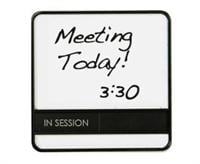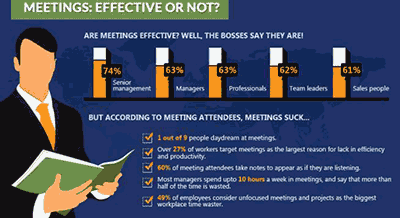Why We’re Focusing on Meetings
 Over the past 15 years, we’ve spent a lot of time helping teams get work done using collaboration software.
Over the past 15 years, we’ve spent a lot of time helping teams get work done using collaboration software.
We’ve worked as developers, consultants, marketers, project managers, and volunteers, with companies and organizations across sectors ranging from local PTAs to international aerospace associations.
We’ve learned a lot. We’ve learned that people are people – from DC to Dingle there are quirky folks and angry folks and rock stars in every group. And when it’s time for these people to work together using software, we’ve come to some clear (perhaps even obvious) conclusions.
Collaboration without meetings doesn’t work
Lots of people hate meetings, or more specifically, the crushing effect most meetings have on their productivity and zest for life. Collaboration tools promise to relieve this burden by allowing teams to work together anytime from anywhere through email, chat, shared documentation, and project tracking.
Groups new to collaboration software envision great open calendars dedicated to productive, un-interrupted time. When team members have a question or something to share, they post it to the collaboration site. Everyone checks in regularly to contribute, but only when it’s not interrupting their “real” work. Meetings, if any, are mostly social.
In practice, relying solely on asynchronous collaboration is a disaster. Simple decisions drag into multi-headed reply-to-all clusters. Team members begin to opt-out as the opinionated few drive the signal-to-noise ratio off the chart.
Over and over, we would see groups that enthusiastically adopted collaboration tools lose the participation of team members. In time, most team repositories show gobs of material posted by two or three people and lots of silent lurkers. Basically, we see the same kind of contribution ratios seen with social media sites. The obvious problem here is that you expect all the members of a working team to contribute. Otherwise, why are they there?
There are groups, though, that have higher online participation than others. While they differ in many ways, each of these groups shares a dedication to meeting regularly. These teams use meetings to confirm decisions, coordinate action plans, ask and answer questions, and help the team connect. Collaboration tools are then used to supplement the meetings, report progress, pose new questions, and share work. Brilliant!
OUR CONCLUSION
Meetings are the most effective way for teams to reach important decisions, coordinate complex activity, and connect. Asynchronous collaboration alone is insufficient. Meetings are necessary for successful teamwork.
Meetings without adequate preparation or follow-through (i.e., between-meeting collaboration) waste time and hurt projects
I’m not going to go into the reasons why so many meetings fail in this post, because that’s been done (1996) and done (2006) and done (2011), and I’m bound to talk ad-infinitum on this topic in the future. Suffice it to say that there are good meetings and bad meetings.
Bad meetings drift. Bad meetings ask people to learn new information together at the slowest person’s pace. Bad meetings request a consensus decision from uninformed teams based on their gut. Bad meetings promote inertia and deferred responsibility. Bad meetings deserve their nasty reputation.
How do you ensure that you’re holding good meetings? Again, this is another topic that’s done, and which we’ll definitely do some more in later posts. The short version is:
- Prepare your team in advance with an agenda, including any information that will help them come ready to contribute
- Stick to your agenda and scheduled time. Take notes about any key points, decisions, and action plans.
- Follow up afterwards. Make sure everyone has a written copy of the important notes, and that any actions assigned are tracked to completion.
These best practices are well known, straight-forward and essential to holding good collaborative meetings, but they’re inconsistently applied. They require the team to work together on the meeting outside of the meeting, and all too often, meetings are treated as separate from the rest of the team’s work.
OUR CONCLUSION
To hold consistently worthwhile meetings, teams need to collaborate outside of meetings, preparing for and following up on their discussions as a matter of course.
Running meetings well is cumbersome, and few have the knowledge or dedication to do so consistently
Yes, we’ve heard the good-meeting basics before. We’ve also all been told to avoid processed foods, exercise at least 30 minutes every day, and to slow down when we see a yellow traffic light.
If you’re one of the rarified few who does indeed workout each morning and flosses twice a day, you’ve probably also figured out how to hold great meetings every time. If that’s you, congratulations! What are you doing here?
If, on the other hand, you’re like the rest of us, you sometimes speed through that orange light and you don’t always get an agenda out for your meetings in advance.
Whether you’re meeting online or face-to-face, the effort required to get prepared, send material out, manage the real-time communication of the meeting, and then make sure you follow-up in a timely way requires a lot of juggling. Those who do follow all these steps use a loose conglomeration of email, desktop tools, online collaboration and conferencing software to get the job done. Ultimately, you’re working on a single meeting with its bits spread all over, and the administrative burden is just too high. The real marvel is not that people fail to follow meeting best practices, but rather that some actually succeed despite the unwieldy effort required.
OUR CONCLUSION
To consistently get the benefit of holding effective meetings, teams need an easy way to follow meeting best practices.
So what are we doing about it?
We think the next step is clear. Today’s online meeting software and collaboration software stand on mature technologies. Based on our years of involvement with online and offline collaboration, we believe holding effective meetings is the key to successful teamwork, because it is during meetings when team members most clearly connect. Using the meeting as a focal point, we combine technologies and best practices from both the collaboration and conferencing realms to provide software that truly enables teams to pursue their goals.
Stay tuned. We’ll use this blog to share more about what we’re trying, what we discover, and how this grand adventure in collaborative meetings pans out in practice. And hopefully with your feedback, we can all look forward to the time when the the “meetings are awesome!” quotes flow freely.



